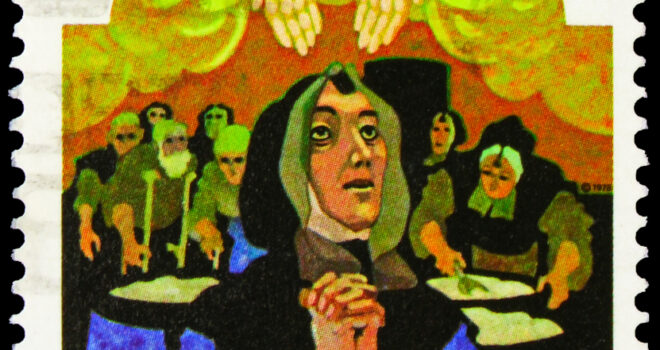When I was asked to write this article about St. Marguerite d’Youville, I admit that I didn’t know much about her. There was a girls’ school in my city named after her several years ago and it has since become a retirement home. As it turns out, I also have St. Marguerite to thank for the hospital in my city—originally begun and staffed by her Sisters—where two of my maternal great-aunts once worked as nurses, and my grandmother worked for a time as a telephone operator. If you ask people in my area, they could tell you about these landmarks but are unfamiliar with the woman behind this legacy.
What I discovered in reading about St. Marguerite is this: when you think that your faith is being tested, turn to her. She is patroness against the death of children, difficult marriages, in-law problems, people ridiculed for piety, victims of adultery, and widows.
St. Marguerite was born on October 15, 1701, in Varennes, Québec (near Montréal) in Canada to an aristocratic family. Her idyllic childhood was shattered when she was seven and her father died. For a few years, St. Marguerite’s great-grandfather paid for her to study at the Ursuline Convent School in Québec. Then, at twelve years of age, she left school to care for and educate her five younger siblings. Although St. Marguerite was beautiful and charming, she was jilted by the man who was courting her since she was from a lower class.
Later, in 1722, she married François d’Youville. Sadly, he was unfaithful and involved in illegal activities, including bootlegging, and made poor financial decisions. His mother lived with them and Marguerite suffered as a result; she also lost four children in infancy. When her husband became ill, St. Marguerite cared for him with great solicitude.
When her husband died after eight years of marriage, St. Marguerite was left penniless with two sons. Despite this, she began her own business to support them and never lost hope. The witness of St. Marguerite’s faith and devotion was evident and inspired both of her sons to become priests. “Few mothers loved their children as tenderly as my mother,” her son Charles wrote. Additionally, she spent a lot of her time caring for the poor, abused, and abandoned as well as visiting the sick and the imprisoned. Her spiritual director Father du Lescoat, PSS told her, “Be comforted, my child, God destines you for a great work, you will raise up a house fallen in ruins.”
In every trial and obstacle, St. Marguerite possessed unwavering trust in God. In his book Under Mary’s Mantle: Our Lady’s Love for Canada, Fr. Émile-Marie Brière writes of her:
“At the age of 26, she received a tremendous grace, an insight into the fatherhood of God and his love for every one of his children. Our Lady had led her quickly to Jesus and Jesus in turn to his Father. The Father, in his Divine Providence, became a central facet of her faith and devotion. Later Marguerite would say, ‘For almost 40 years the Eternal Father has been the object of all my confidence,’ and ‘I leave all to Divine Providence. My confidence is in it.’”
In many ways, her charity reflected that of the Blessed Virgin Mary. St. Marguerite cared for the needy in her own home and even invited a blind woman to live with her on November 12, 1737, the Feast of the Presentation of Mary in the Temple. Three other women moved in with her and joined her efforts. In 1737, St. Marguerite founded the Sisters of Charity of Montréal and they became known as the Grey Nuns because of their habits. “Their first act was to kneel before a statue of Our Lady of Providence and consecrate themselves to God,” explained Fr. Brière. “They placed their work of service under Mary’s protection.” (Under Mary’s Mantle, 93)
Due to her husband’s reputation, people spread untrue rumors about her and the nuns, calling them “drunken.” (In French the word grey can also mean “tipsy.” So, the Grey Nuns became known as the “tipsy nuns.”) As a result, some priests denied them Holy Communion and townspeople even threw stones at them. While grieving the death of one of her companions, a fire destroyed their home on January 31, 1745 and some even alleged that the Sisters were drunk and started it themselves! Instead of becoming discouraged, St. Marguerite said: “What can we learn from this? Perhaps we have been too well off. Now we will have to live more poorly. We ought not to be more comfortable than the poor.”
St. Marguerite suffered from illness and frailty. In 1747, she was appointed Directress of the General Hospital of Montréal (Charon Brothers Hospital) and was so weak she had to be carried to the hospital in a cart! On the October 7, the Feast of the Holy Rosary, she arrived to begin her mission in imitation of Our Lady. She successfully restored the hospital which was in a terrible state of disrepair. St. Marguerite and her Sisters cared for everyone: disabled soldiers, the elderly, the mentally ill, orphans, and those who were considered hopeless. They also rescued babies who were abandoned in the streets. During the Seven Years’ War between France and England, the Grey Nuns took care of the wounded on both sides. In 1759, Montréal was struck by a famine. The hospital was even without bread. Then, she and her sisters found several barrels of flour in the dining room and could never discover where it came from (Illustrated Story on Her Life).
Although fire ruined the hospital in 1765, the painting of the Eternal Father and the statue of Our Lady of Providence were spared. St. Marguerite and her Sisters did not despair. They knelt and prayed the Te Deum and undertook the rebuilding of the hospital, with the help of the natives they had cared for in the smallpox epidemic.
Following her death, the Grey Nuns established hospitals, schools, and orphanages throughout Canada, the United States, Africa, and South America. Her Sisters are especially dedicated to work with Eskimos. Their sister communities also continue St. Marguerite’s work far and wide: the Sisters of Charity of St. Hyacinthe, the Sisters of Charity at Ottawa, the Sisters of Charity of Québec , the Grey Nuns of the Sacred Heart (Philadelphia) and the Grey Sisters of the Immaculate Conception (Pembroke).
Over the course of her life, St. Marguerite served in the Canadian wilderness for several years and survived Native American attacks, plagues, and fires. Truly, she was a “Tower of Trust in God,” and the witness of her life invites us to abandon ourselves wholly to Divine Providence. As Professor Roberto de Mattei explains in his new book The Meaning of God’s Providence in our Lives:
“The mystery of Providence is that of a God who is not indifferent to that which He has created, but instead regards everything that concerns even the smallest creature, since ‘from Him and through Him and for Him are all things’ (Rom. 11:36). If God cares for every minute detail of the universe, should it be even a grain of sand, what then should we think of His care for man, created in His image and likeness, in whom He Himself became incarnate?”
This is why, throughout her life’s struggles, St. Marguerite shared, “I have never lost confidence in our Eternal Father” and could be found alone in prayer.
Regardless of our hardships, St. Marguerite is a friend that we can turn to in our suffering. She “can sympathize with the unfortunate and painful situation of so many orphans, with adolescents worried about the future, with disillusioned girls who live without hope, with married women suffering from unrequited love and with single parents. But most especially, Marguerite is a kindred spirit with all who have given their lives to helping others.” (Holy See)
Having spent herself fully in love for God and all those in need, St. Marguerite died on December 23, 1771, and a luminous cross appeared over the hospital. She is known as the “Mother of Universal Charity” and her feast day is October 16. St. Marguerite, first native Canadian saint, pray for us!
Sources:
- “Marie-Marguerite d’Youville”
- “St. Marguerite d’Youville: One of the greatest Catholic women yet to live in the New World” by Meg Hunter-Kilmer:.
- Under Mary’s Mantle: Our Lady’s Love for Canada by Fr. Émile-Marie Brière.












